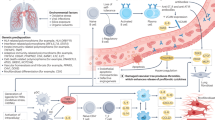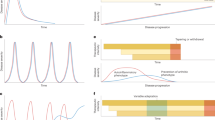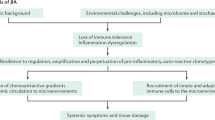Abstract
During the past 10 years, descriptions of large registries of children with juvenile systemic sclerosis (jSSc) have improved our knowledge of this disease. jSSc differs from the adult disease in presentation as well as disease course. Two courses of disease have been described: a rapidly progressive and fatal illness with cardiac involvement; and, more commonly, a chronic course with less overall mortality. Subclinical disease, especially cardiac and pulmonary disease, should be specifically sought and appropriately monitored, particularly in the first years of disease. Use of screening pulmonary function tests and high-resolution CT increases the chance of detecting interstitial lung disease. Close attention needs to be paid to cardiac health, with improved understanding of the specific causes of death to aid in the development of preventive measures. Therapies that best balance risks and benefits are likely to differ between children and adults. Given the relative rarity of jSSc, pediatric trials will require multinational collaborative efforts.
This is a preview of subscription content, access via your institution
Access options
Subscribe to this journal
Receive 12 print issues and online access
$209.00 per year
only $17.42 per issue
Buy this article
- Purchase on Springer Link
- Instant access to full article PDF
Prices may be subject to local taxes which are calculated during checkout


Similar content being viewed by others
References
Zulian, F. et al. Juvenile localized scleroderma: clinical and epidemiological features in 750 children. An international study. Rheumatology (Oxford) 45, 614–620 (2006).
Foeldvari, I. et al. Favourable outcome in 135 children with systemic sclerosis: results of a multi-national survey. Rheumatology (Oxford) 39, 556–559 (2000).
Martini, G. et al. Systemic sclerosis in childhood: clinical and immunological features of 153 patients in an international database. Arthritis Rheum. 54, 3971–3978 (2006).
Scalapino, K. et al. Childhood onset systemic sclerosis: classification, clinical and serologic features, and survival in comparison with adult onset disease. J. Rheumatol. 33, 1004–1013 (2006).
Zulian, F. et al. The Pediatric Rheumatology European Society/American College of Rheumatology/European League against Rheumatism provisional classification criteria for juvenile systemic sclerosis. Arthritis Rheum. 57, 203–212 (2007).
Hunzelmann, N. et al. The registry of the German Network for Systemic Scleroderma: frequency of disease subsets and patterns of organ involvement. Rheumatology (Oxford) 47, 1185–1192 (2008).
Foeldvari, I. & Wierk, A. Healthy children have a significantly increased skin score assessed with the modified Rodnan skin score. Rheumatology (Oxford) 45, 76–78 (2006).
Leroy, E. C. et al. Scleroderma (systemic sclerosis): classification, subsets and pathogenesis. J. Rheumatol. 15, 202–205 (1988).
Nigrovic, P. A., Fuhlbrigge, R. C. & Sundel, R. P. Raynaud's phenomenon in children: a retrospective review of 123 patients. Pediatrics 111, 715–721 (2003).
Dolezalova, P., Young, S. P., Bacon, P. A. & Southwood, T. R. Nailfold capillary microscopy in healthy children and in childhood rheumatic disease: a prospective single blind observational study. Ann. Rheum. Dis. 62, 444–449 (2003).
Silver, R. M., Miller, K. S., Kinsella, M. B., Smith, E. A. & Schabel, S. I. Evaluation and management of scleroderma lung disease using bronchoalveolar lavage. Am. J. Med. 88, 470–476 (1990).
Garty, B. Z. et al. Pulmonary function in children with progressive systemic sclerosis. Pediatrics 88, 1161–1167 (1991).
Seely, J. M., Jones, L. T., Wallace, C., Sherry, D. & Effmann, E. L. Systemic sclerosis: using high-resolution CT to detect lung disease in children. AJR Am. J. Roentgenol. 170, 691–697 (1998).
Panigada, S. et al. HRCT and pulmonary function tests in monitoring of lung involvement in juvenile systemic sclerosis. Pediatr. Pulmonol. 44, 1226–1234 (2009).
BAL Cooperative Group Steering Committee. Bronchoalveolar lavage constituents in healthy individuals, idiopathic pulmonary fibrosis, and selected comparison groups. Am. Rev. Respir. Dis. 141, S169–S202 (1990).
Witt, C. et al. Pulmonary involvement in diffuse cutaneous systemic sclerosis: broncheoalveolar fluid granulocytosis predicts progression of fibrosing alveolitis. Ann. Rheum. Dis. 58, 635–640 (1999).
Strange, C. et al. Bronchoalveolar lavage and response to cyclophosphamide in scleroderma interstitial lung disease. Am. J. Respir. Crit. Care Med. 177, 91–98 (2008).
Galie, N. et al. Guidelines for the diagnosis and treatment of pulmonary hypertension. Eur. Respir. J. 34, 1219–1263 (2009).
Williams, M. H. et al. Role of N-terminal brain natriuretic peptide (N-TproBNP) in scleroderma-associated pulmonary arterial hypertension. Eur. Heart J. 27, 1485–1494 (2006).
Meune, C., Vignaux, O., Kahan, A. & Allanore, Y. Heart involvement in systemic sclerosis: evolving concept and diagnostic methodologies. Arch. Cardiovasc. Dis. 103, 46–52 (2010).
Martini, G. et al. Factors affecting survival in juvenile systemic sclerosis. Rheumatology (Oxford) 48, 119–122 (2009).
Barst, R. J., Ertel, S. I., Beghetti, M. & Ivy, D. D. Pulmonary arterial hypertension: a comparison between children and adults. Eur. Respir. J. 37, 665–677 (2011).
Kowal-Bielecka, O. et al. EULAR recommendations for the treatment of systemic sclerosis: a report from the EULAR Scleroderma Trials and Research group (EUSTAR). Ann. Rheum. Dis. 68, 620–628 (2009).
Tissot, C., Ivy, D. D. & Beghetti, M. Medical therapy for pediatric pulmonary arterial hypertension. J. Pediatr. 157, 528–532 (2010).
Wozniak, J. et al. Evaluation of heart rhythm variability and arrhythmia in children with systemic and localized scleroderma. J. Rheumatol. 36, 191–196 (2009).
Sánchez-Román, J. et al. Screening for PAH in patients with systemic sclerosis: focus on Doppler echocardiography. Rheumatology (Oxford) 47 (Suppl. 5), v33–v35 (2008).
Bussone, G., Bérezné, A., Pestre, V., Guillevin, L. & Mouthon, L. The scleroderma kidney: progress in risk factors, therapy, and prevention. Curr. Rheumatol. Rep. 13, 37–43 (2011).
Hamaguchi, Y. Autoantibody profiles in systemic sclerosis: predictive value for clinical evaluation and prognosis. J. Dermatol. 37, 42–53 (2010).
Tashkin, D. P. et al. Cyclophosphamide versus placebo in scleroderma lung disease. N. Engl. J. Med. 354, 2655–2666 (2006).
Au, K., Khanna, D., Clements, P. J., Furst, D. E. & Tashkin, D. P. Current concepts in disease-modifying therapy for systemic sclerosis-associated interstitial lung disease: lessons from clinical trials. Curr. Rheumatol. Rep. 11, 111–119 (2009).
Khanna, D., Furst, D. E., Clements, P. J., Tashkin, D. P. & Eckman, M. H. Oral cyclophosphamide for active scleroderma lung disease: a decision analysis. Med. Decis. Making 28, 926–937 (2008).
Su, R. et al. An analysis of connective tissue disease-associated interstitial lung disease at a US Tertiary Care Center: better survival in patients with systemic sclerosis. J. Rheumatol. 38, 693–711 (2011).
Author information
Authors and Affiliations
Ethics declarations
Competing interests
The author declares no competing financial interests.
Rights and permissions
About this article
Cite this article
Rabinovich, C. Challenges in the diagnosis and treatment of juvenile systemic sclerosis. Nat Rev Rheumatol 7, 676–680 (2011). https://doi.org/10.1038/nrrheum.2011.148
Published:
Issue Date:
DOI: https://doi.org/10.1038/nrrheum.2011.148



